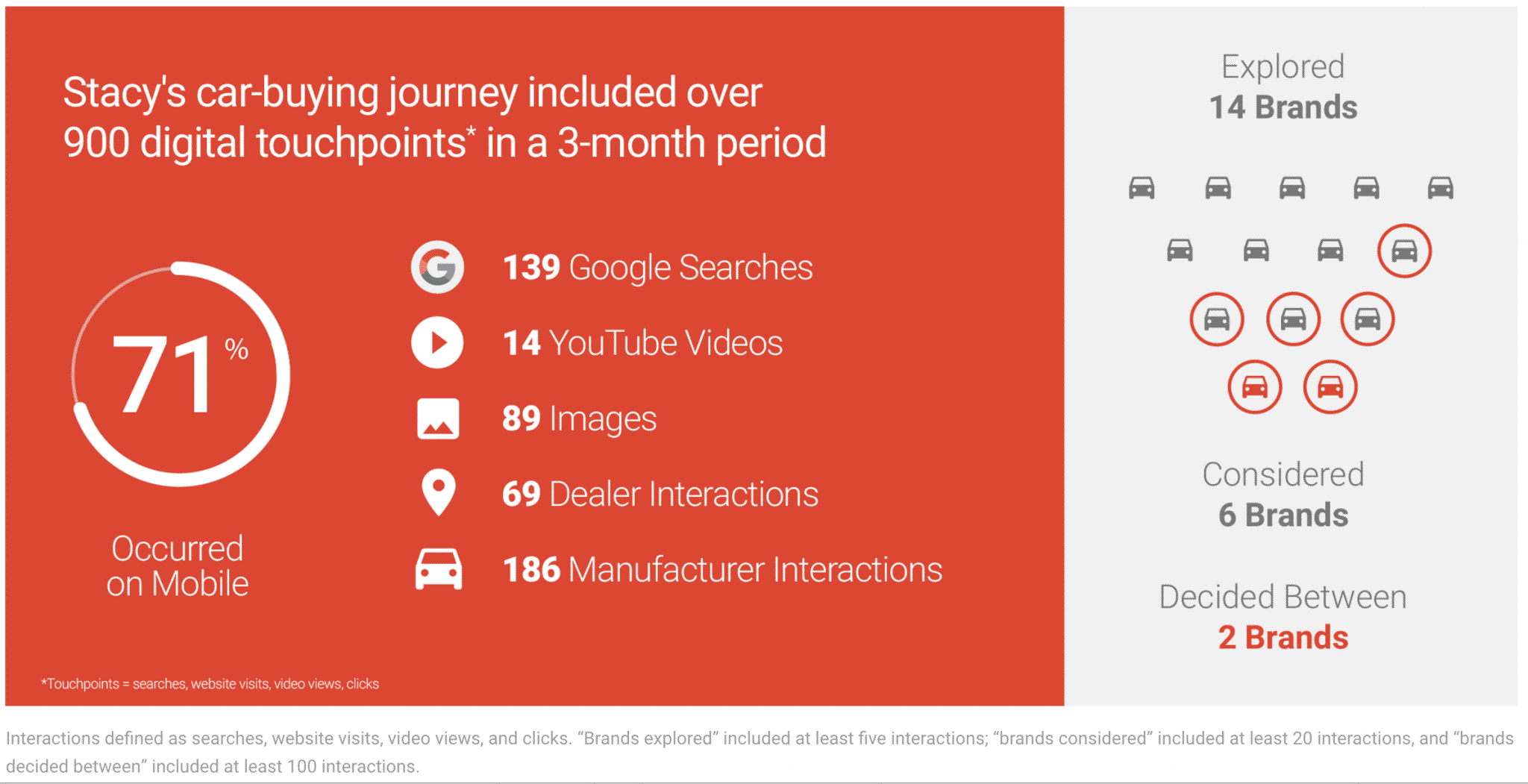 Before we dig into the buyer’s journey we need to understand exactly who your buyers are. This begins with identifying the personas/avatars for each prospect/customer for our business. Without this first step you can’t possibly develop a great buyer’s journey and content strategy that supports it. So do the work. Through understanding your buyers problem you become better equipped to provide the solutions.
Before we dig into the buyer’s journey we need to understand exactly who your buyers are. This begins with identifying the personas/avatars for each prospect/customer for our business. Without this first step you can’t possibly develop a great buyer’s journey and content strategy that supports it. So do the work. Through understanding your buyers problem you become better equipped to provide the solutions.
When most people make a purchase of significant value, they research the product they need, find different brands, and compare them to each other in order to find the one that best meets the need.
Then, after they have narrowed their choices, they will make a decision to buy the product based on its options and the price. This decision-making process is part of what is called the buyer’s journey.
Three Parts of the Journey
There are three components to the buyer’s journey:
1. Awareness
2. Consideration
3. Decision
Awareness
The awareness part of the buyer’s journey begins when the customer becomes aware of a problem. They may discover that the inside of their refrigerator is too hot, or their car’s alternator may be malfunctioning more frequently. They will go on to find a solution to their problem, which may mean calling an appliance company to repair their refrigerator or looking for a mechanic.
Consideration
During this part of the journey, buyers will start researching the solutions to their problems. They may go online to find an appliance company that repairs refrigerators, or they may start looking for mechanics that have the services they need. In the digital age, most research is done online, because people can log onto their computers or smartphones whenever they have time without being pressured into decisions by salespeople.
Decisions
Once they’ve found a shop that matches their criteria or appliance companies that fix their brand of refrigerator, the buyer will then make a decision about purchasing what they need. The decision may involve comparing services to see which appliance company repairs their brand of refrigerator, or which shop charges the least for repairs.
This three-part buyer’s journey happens with every purchase a customer makes. If it is noon and they are hungry (the problem), they will consider what they want to eat and then decide where to go to obtain the food they want. If their shoe has a hole in it, the customer may go to the mall and look at the shoe selections in a few different shoe stores to find the type of shoes they want, and then decide where to buy them.
The Buyer’s Journey in the Digital Age

While the buyer’s journey may seem simple, it can actually be quite complicated these days. Research has shown that 81% of buyers will research the products they need online before making a purchase. If that customer is a business, that statistic is higher, with 94% of business customers going online to research solutions for their needs.
The research process, which is done during both the awareness and consideration steps of the buyer’s journey, isn’t necessarily as simple as looking up cars that will seat five passengers. Customers may start with the features they need in order to narrow down their choices, but then they will compare vehicles with those features, and visit the websites of different car brands and dealerships. They may read reviews on the vehicles on their list, and then read reviews about the dealerships in their area offering the vehicle they want.
Depending on the size of the purchase, and the immediacy with which they need a solution, the buyer’s journey may take a few hours or several weeks. It is important to know the buyer’s journey in order to market your products or services to your target audience. Using this information will allow you to develop your website’s SEO to influence customers to buy from your company.
It can also help promote your business to the influencers within your industry, which is known as evangelizing.
Luth Research was able to follow one consumers journey while searching for a car. The Car-Buying Process: One Consumer’s 900+ Digital Interactions. Very interesting process and can help you to think about your buyers journey.
Stacy is a 32-year-old mother of two. At the time of her search, she drove a mid-size SUV that fit her family of four. But with a third child on the way, she needed a new car that would fit three car seats, and so she had to decide between leasing a larger SUV or going with a minivan.


SEO and the Buyer’s Journey
In order to be successful in the digital age, you need to be able to draw traffic to your website in order to find customers for your products or services. The content posted on your website, whether it is articles, videos or images, is what will attract attention to your business and the products or services you offer. By learning the buyer’s journey, content can be created to help influence buyers during each stage and lead them to purchase your products or services.
Creating Content for Awareness
Remember that during the awareness stage, the buyer becomes aware of a problem and begins to seek a solution to that problem. The content on your website can help potential customers better understand the problem they are having, and it can lead them to a solution. For instance, if your company sells window treatments, you have to help customers realize that they need window treatments for their new home, and help them discover your products as their solution.
Becoming aware of a problem usually happens quickly, so you will want to concentrate on helping searchers realize your products are the solution to their problems. If buyers weren’t already aware they had a problem, they wouldn’t be online searching for solutions. Placing the appropriate keywords in your website’s content can help bring awareness to your products as a solution.
If a buyer needs window shades that block the sunlight, then you might use “sun blocking shades” in the product descriptions on your site. You also may include articles on how to install “sun blocking shades” on your site and include the keyword in the image of the sun blocking shades that your company sells. When the buyer does a search for “sun blocking shades,” then your website will appear on search engine results pages during the awareness stage.
Creating Content for Consideration
During the consideration stage, buyers will be researching products to find the ones they need to solve their problem. They will look for products that have the features they want. In the case of window treatments, they may be looking for roller shades that block sunlight so they can sleep during the daytime because they work nights. They may also need customized roller shades, because they have odd-sized windows that make it difficult to find prefabricated shades that fit the window properly.
To have buyers consider your products, the content on your website needs to address the features of your window treatments. For instance, your sun blocking roller shades may be available in 10 colors, your company may offer prefabricated roller shades in several sizes, and you may also offer custom-made roller shades. In addition, your company may also offer mini blinds, roman shades and a variety of other window treatments for both residential and commercial buyers.
You may post articles on your website indicating the benefits of your sun block roller shades. There may be color swatch images on your site showing customers their options, or you can include how-to videos showing customers how to measure their windows so they can order the proper size shades. Keywords used in your content should help buyers see your products as their solution, so you might include “sun blocking shade customer reviews” to direct them to the webpage where customers have made comments about your products.
Creating Content for Decision
This is where your content needs to make buyers conclude that they should buy your products to solve their problem. After providing them with content with all the information they need to consider your window treatments for their home or business, your site should sway them to buy your window treatments. You can do this by offering special promotions and discounts on purchasing valium diazepam for anxiety disorder treatments for more than one window, and by making it easy for buyers to purchase your products online.
Something as simple as offering a shopping cart process on your website could sway a buyer into purchasing your products to dress their home’s windows. Offering discounts for buying treatments for more than one window will help sway some buyers. Some of the keywords to include on your website may be “two for one discount” or “roller shade sale.”
Some of the content on your website will help “sell” your products to influencers within your industry as well. Interior designers may be persuaded to recommend your window treatments to their clients based on the content on your site. A keyword could indicate your company has the “best window treatments” within your industry, or you could offer “designer discounts” on your products.
In Preparation
You need to ask yourself these questions:
- How many personas do you have?
- What keywords do they search for on Google?
- What channels and devices do they use at each stage?
- What questions do they have? Who are they asking those questions to?
Once you have a clear picture of your buyers journey then you can prepare the content and information they need to make the decision that you are the right solution to their problem.
The content that is developed for each stage of the buyer’s journey should not only help find and sell new customers on the idea of buying your products, but it should also help retain your current list of customers. Encourage your customers to provide feedback on your site. Write content that responds to frequently asked questions from your customers, or interact with them through your social media. A good content marketing strategy for each stage of the buyer’s journey can help increase your sales and help make your business an industry leader.
